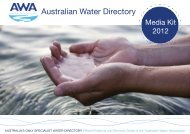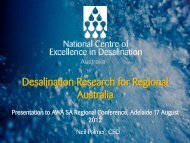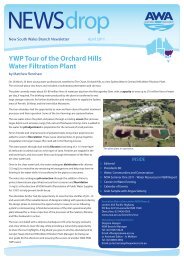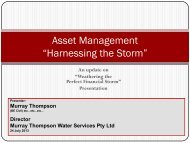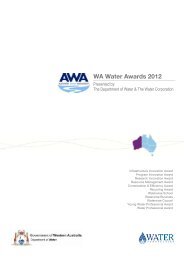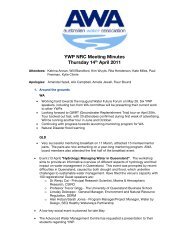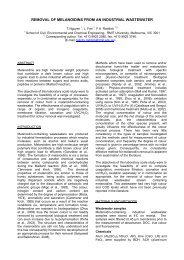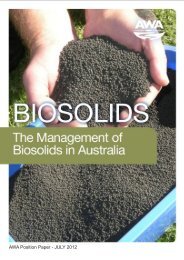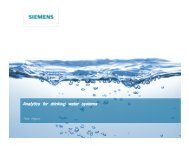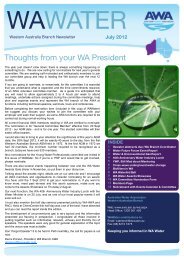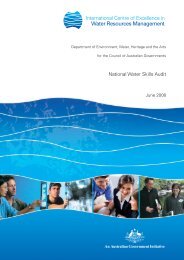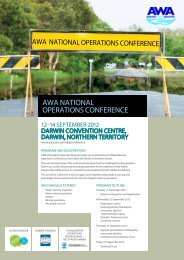Optimum Use of Subsidies for Reducing Domestic Water Consumption
Optimum Use of Subsidies for Reducing Domestic Water Consumption
Optimum Use of Subsidies for Reducing Domestic Water Consumption
Create successful ePaper yourself
Turn your PDF publications into a flip-book with our unique Google optimized e-Paper software.
the fact that these two reference points lie within<br />
the dominated area <strong>of</strong> the Pareto curve. The<br />
horizontal distance that these points lie above the<br />
curve, multiplied by the water savings achieved,<br />
represents the potential cost savings which could<br />
have been realised if rebate choices and prices<br />
were optimally <strong>for</strong>mulated. For South Australia, this<br />
represents removing rebates <strong>for</strong> 1000L tanks,<br />
reducing the rebate incentive <strong>for</strong> washing<br />
machines and most tank rebate options and<br />
increasing the rebate incentive <strong>for</strong> showerheads<br />
and pool covers to $60 and $300 respectively.<br />
CONCLUSION<br />
This research develops and demonstrates a new<br />
framework <strong>for</strong> Australian and international<br />
policymakers to <strong>for</strong>mulate optimal rebate policies<br />
<strong>for</strong> water saving measures to reduce household<br />
water consumption. Multi-objective genetic<br />
algorithm optimisation techniques were<br />
successfully applied <strong>for</strong> the first time in this context<br />
to allow policymakers to develop a Pareto efficient<br />
frontier <strong>of</strong> optimal policy mixes.<br />
A review <strong>of</strong> historical rebate programs produces<br />
new knowledge about the drivers and expected<br />
response <strong>of</strong> Australian consumers to rebate<br />
programs. Applying behavioural end-use stochastic<br />
simulation, this research demonstrates a new<br />
method <strong>of</strong> estimating water savings from retr<strong>of</strong>it<br />
and rainwater tank installation measures.<br />
Through the application <strong>of</strong> a <strong>for</strong>mal optimisation<br />
framework, our results demonstrate that improved<br />
economic and environmental outcomes can be<br />
achieved. Current methods <strong>of</strong> evaluating program<br />
success – through ex-post economic analysis – are<br />
plagued as they are retrospective and <strong>of</strong>ten rely on<br />
poor or exaggerated water savings estimates.<br />
Least cost planning methods which identify the<br />
levelised cost <strong>of</strong> measures in isolation are useful<br />
only to <strong>for</strong>mulate policy when budgets are<br />
unconstrained. Our framework improves upon<br />
both through ex-ante estimation <strong>of</strong> yield and cost<br />
with an uptake model, improved estimates <strong>of</strong> water<br />
savings and consideration <strong>of</strong> measures in<br />
combination.<br />
Table 1 – Potential improvements from the application <strong>of</strong><br />
the proposed framework <strong>for</strong> three case study schemes<br />
SA<br />
WA<br />
Previous Rebate<br />
Scheme<br />
Economically<br />
Efficient<br />
At Similar <strong>Water</strong><br />
Saved<br />
Previous Rebate<br />
Scheme<br />
Economically<br />
Efficient<br />
At Similar <strong>Water</strong><br />
Saved<br />
Cost<br />
($m)<br />
<strong>Water</strong><br />
Saved<br />
(GL)<br />
$/kL<br />
$48.2 19.3 2.50<br />
$101.3 42.6 2.38<br />
$27<br />
(-44%)<br />
19.5 1.39<br />
$22.8 19.2 1.19<br />
$54.5 52.1 1.05<br />
$9.7<br />
(-58%)<br />
19.1 0.51<br />
REFERENCES<br />
Barton, A. 2003. Investigation into the<br />
Characteristics <strong>of</strong> Residential <strong>Water</strong> <strong>Use</strong> In<br />
Adelaide, In: Association, A. W. (ed.) AWA SA<br />
Branch Regional Conference. Adelaide, South<br />
Australia.<br />
Breen, P., Coleman, J., Deletic, A., Duncan, H.,<br />
Fletcher, T., Gerhart, T., Grant, A., Holt, P., Inman,<br />
M., Maheepala, S., Mitchell, G., Sharma, A. K.,<br />
Stewart, J., Rahilly, M. & Vieritz, A. 2006.<br />
Integrated Urban <strong>Water</strong> Modelling Review Stage 2<br />
Report In: CRC, E. (ed.). Australia.<br />
Coombes, P. J. & Kuczera, G. 2003. Analysis <strong>of</strong><br />
the Per<strong>for</strong>mance <strong>of</strong> Rainwater Tanks in Australian<br />
Capital Cities. 28th International Hydrology and<br />
<strong>Water</strong> Resources Symposium Wollongong NSW:<br />
The Institution <strong>of</strong> Engineers, Australia.<br />
Deb, K., Pratap, A., Agarwal, S. & Meyarivan, T.<br />
2002. A Fast and Elitist Multi-Objective Genetic<br />
Algorithm: NSGA-II. IEEE Transactions on<br />
Evolutionary Computation, Vol. 6.<br />
Gillingham, K. 2009. Economic efficiency <strong>of</strong> solar<br />
hot water policy in New Zealand. Energy Policy,<br />
37, 3336-3347.<br />
Loh, M. & Coghlan, P. 2003. <strong>Domestic</strong> <strong>Water</strong> <strong>Use</strong><br />
Study. In: CORPORATION, W. (ed.).<br />
Millock, K. & Nauges, C. 2010. Household<br />
Adoption <strong>of</strong> <strong>Water</strong>-Efficient Equipment: The Role <strong>of</strong><br />
Socio-Economic Factors, Environmental Attitudes<br />
and Policy. Environmental & Resource Economics.<br />
Olmstead, S., M. & Stavins, R. 2008. Comparing<br />
price and non-price approaches to urban water<br />
conservation. Harvard University.<br />
Roberts, P. 2005. Residential End <strong>Use</strong><br />
Measurement Study - Final Report. Yarra Valley<br />
<strong>Water</strong>.<br />
Savic, D. A., Bicik, J. & Morley, M. S. 2011. A DSS<br />
generator <strong>for</strong> multiobjective optimisation <strong>of</strong><br />
spreadsheet-based models. Environmental<br />
Modelling S<strong>of</strong>tware, 26, 551-561.<br />
Thyer, M., Micevski, T., Kuczera, G., Coombes, P.<br />
(2011). „A Behavioural Approach to Stochastic End<br />
<strong>Use</strong> Modelling.‟ Paper presented at Oz <strong>Water</strong>, 9-11<br />
May 2011, Adelaide.<br />
White, S. B. & Fane, S. A. 2007. Designing Cost<br />
Effective <strong>Water</strong> Demand Management Programs in<br />
Australia. <strong>Water</strong> Science and Technology, 225-<br />
232.



